Step-by-step cultivation of cucumbers in a barrel, photos and useful tips
Many gardeners want to show off the originality of their site in front of their neighbors. And how to do this when everyone grows the same thing? Change the appearance of the site by planting the plants differently. The method of growing cucumbers in a barrel will definitely suit your taste, because it will help not only surprise guests, but also significantly save space. And this is just a small part of the advantages, you will learn about the rest from our article.
The content of the article
Features of growing cucumbers in barrels
This method has long won the love of gardeners due to the unusual appearance of the familiar vegetable, ease of care and harvesting. Having drawn conclusions about the merits of planting in a barrel, summer residents plant other crops in a similar way.
Benefits of the vertical growing method
This original planting method has a lot of advantages:
- saving space in the garden;
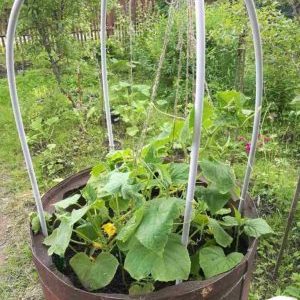
- no need to bend over while harvesting;
- all fruits are in sight and are not contaminated with soil;
- simplified root watering;
- plantings are illuminated evenly;
- cucumber whips are not trampled underfoot;
- a small amount of weeds, because the planting area is small;
- warming the root soil in a barrel with sunlight and humus, which significantly increases the yield;
- less susceptibility to disease due to elevation above the ground;
- spectacular appearance;
- a whole barrel of finished compost in the fall.
Disadvantages of barrel growing
There are small drawbacks that, with the proper approach, are easy to eliminate:
- the need to constantly water the seedlings, because cucumbers have no other way to get moisture, for example, by absorbing groundwater;
- backfilling of land at the stage of active growth;
- the need to purchase containers for planting;
- filling the container with the correct composition in a large volume before planting.
What is required for planting cucumbers in a barrel
To plant cucumbers in a barrel you will need:
- capacity;
- barrel filling composition;
- heated water for irrigation and boiling water for soil disinfection;
- material for sheltering seedlings - oilcloth with a diameter slightly larger than the size of the barrel or plastic cans without a bottom;
- material for the frame (prepare until the plants lower the whips).
Barrels
The best barrels for planting are wood, metal and plastic. Wooden is preferable. They breathe well and do not heat up in the sun as much as metal ones. But even plastic is fine. Convenient barrels with a volume of 150-200 liters.
Attention! Cucumbers love sunlight, but metal barrels overheat very quickly and cool down just as quickly in the shade. Rapid temperature changes are harmful to delicate crops.
Cucumber varieties
Give preference to early maturing, high-yielding varieties and hybrids. Cucumbers are perfect for open beds, pollinated by bees and independently. Especially productive:
- Fontanelle F1;
- Competitor;
- Pace F1;
- Swallow F1;
- Masha F1;
- Amur F1;
- Prestige F1.
Step-by-step instructions for growing cucumbers in a barrel
Most of the work falls into the pre-planting phase. The further process is not very different from other methods of growing cucumbers.
Preparatory stage
The barrel method requires responsible preparation after the snow melts in the spring:
- Choose a shady, draft-free location for drum installation. Provide free access to landings from all sides.
- Remove the bottom from the planting container or make several large holes to avoid stagnation of excess moisture.
- Fill the barrel 1/3 full with branches, pebbles, rags, tops and other plant debris that will act as drainage.
- Fill the next third with rotted manure. It will warm the root system of the plants from below. If there is no manure, mowed grass, sawdust mixed with soil, tree bark, and small amounts of food waste will do.
- The top layer is fertile light soil. Fill it up, leaving 10 cm to the edge of the barrel. This will make it possible to cover the seedlings at first from possible frosts and at night.
- Until the sprouts have reached the edge of the barrel, it is enough to cover them simply with foil or acrylic.
- For further growth, young lashes need a frame. It is made from narrow slats, plastic arches for a greenhouse and other suitable material. If the drums are positioned along the wall, extend the rope support from the ground in the tank and secure to the wall. As the leaf mass grows, you will end up with a cucumber wall (like hops or girlish grapes), which looks very original with juicy fruits.
Landing
You can grow seedlings or sow seeds directly into the ground. If you plan to plant seeds in a barrel, proceed as follows:
- Spill well the soil in the barrel 1-2 days before planting. Some shrinkage should occur, so add fertile soil to the original level.
- In the prepared loosened soil, make small holes - 2-3 cm deep. Calculate their number by the number of seeds (no more than 6 per 1 barrel) plus 2-3 seeds in case of poor germination and weak seedlings.
- Then cover the seeds with rotted humus.
- In the early days and before the appearance of strong seedlings, gently water the cucumbers with warm water from a watering can with a fine sprinkler.
- Then cover the seedlings with foil and pull them with twine along the outside of the barrel, thus obtaining a greenhouse.
Care
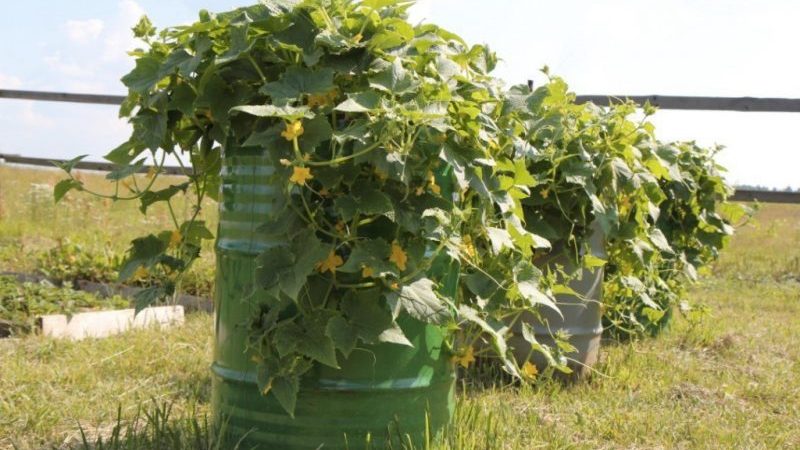
To get large amounts of crispy fruit in a relatively short period of time, properly care for the crop.
Important! Remember that cucumbers cannot be planted in their old place for 4 years. Change the soil in the barrel completely for each next generation.
Watering
Watering produce as the top layer of the earth dries out. Usually 2 times a week under the root. In very hot weather, check frequently to see if the plants need life-giving moisture.
With watering, the soil gradually subsides. Do not forget to add soil as the seedlings grow. This will have to be done several times during the season.
Garter
If you plan to put the whips up, install the frame with small sprouts, directing the branches along it. If the whips hang down, be sure to soften the edge of the barrel so that in the future the branches that are heavy from the fruit do not break. Smooth the edge of the barrel with a bicycle tire, rolled cloth, etc. If you are growing cucumbers in an iron container, it is better to immediately wrap it in foil to avoid overheating the ground.
Tying your plants will help prevent fragile stems from breaking. This will make it easier to direct the growth of the cucumbers in the right direction along the frame, and when they reach the top, they will fall, no longer injuring themselves on the edge of the barrel.
Topping
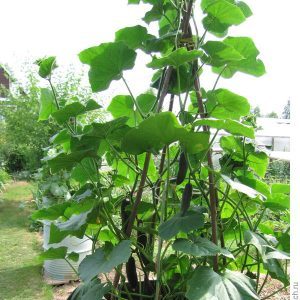
Pinching increases the yield.The first option is for self-pollinated varieties (forming into 1 stem):
- Remove flowers and stepchildren in the first five sheets.
- In the next five sheets, remove only the side shoots.
- When the length of the shoot reaches 1 m, save a few stepsons, which you pinch after 3-4 leaves. Thanks to these actions, shoots of the third order are formed.
For bee-pollinated varieties, the method of forming a bush is used by pinching the main stem over the fifth leaf. Later stepchildren will appear, who also pinch over the fifth sheet. Such actions stimulate the formation of mainly the maternal ovary. This contributes to the formation of about 10 additional lashes.
Top dressing
Fertilization is an important part of care... The first top dressing spend 1-2 weeks after removing the film. The simplest composition is manure with water in a ratio of 1:10.
Before flowering, cucumbers are fed with mineral fertilizers (superphosphate, potassium sulfate). Mulching the top layer with humus will help to achieve an earlier ripening of the fruit.
Diseases and pests
To prevent pests:
- before planting, pour boiling water over the barrel with a solution of potassium permanganate or Fitosporin;
- timely inspect plants for larvae and damage to the leaf mass;
- Weed carefully at all stages of growth.
Among the most common pests:
- Melon aphid. Its colonies are located at the bottom of the leaf. They multiply very quickly, eventually sticking to the whole plant with a sticky composition. Careful disinfection of the soil before planting and timely weeding serve as prevention. If you find aphids early in the capture of the plant, dust it with sifted ash. Spray the plant itself with a mixture of 200 g of ash and a soap solution (50 g of soap per 10 liters of water). Water the undersides of the leaves from bottom to top.
- Spider mite. It is determined by the cobweb that braids the lower part of the leaves and stems. Initially, on the underside of the leaf, mites are visible as small black dots. They suck out nutrients from the leaves, as a result of which they curl and dry out. The tick starts up from a lack of moisture or is brought in with the remains of affected plants. The fight against him is carried out with infusions of onion and garlic husks.
- Whitefly, like the tick, it feeds on juices from the lower part of the leaf. Frequent spraying of the underside of the leaves with water and treatment of the cucumber culture with Inta-Virom help to cope with it.
- Slugs. They are identified by the shiny slime strips they leave both on plants and on the ground. The pest is very gluttonous. Pollination with ash and scattering of metaldehyde granules helps to get rid of it.
Common diseases include:
- Powdery mildew. A white powdery bloom appears on the leaves, then the bush stops bearing fruit. The cause of the appearance of powdery mildew is an excess of nitrogen fertilizers, a lack of watering, low temperatures and non-compliance with crop rotation. The plant is saved with a solution of copper oxychloride, colloidal sulfur, or a mixture of sour milk and warm water in equal proportions.
- Peronosporosis - yellowish spots, increasing in size, affect the leaves. A disease arises from excess moisture and cold watering. If found, stop feeding and watering and immediately treat the plant with a solution of polycarbocin or copper oxychloride.
- Cladosporium - brownish-green ulcers on stems, leaves and fruits. A fungal disease that occurs in cool, damp weather and with sudden changes in temperature, manifests itself more often in the autumn. To secure planting next year, carefully remove the remnants of infected plants and fruits from the site. Create greenhouse conditions for the cucumber up to + 20 ° C and stop watering for 5 days. Treat it with a solution of Bordeaux liquid, copper oxychloride, etc.
- Different types of rot (gray, white, root). For prophylaxis, observe crop rotation and do not allow contaminated plant residues to enter fresh soil.
Possible problems in the growing process
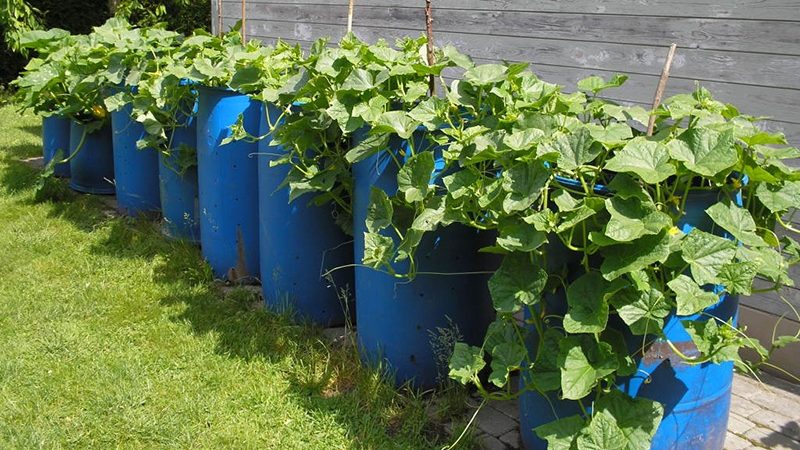
Inexperienced gardeners often have the following difficulties:
- drying out of the soil if neglected;
- overheating of the roots due to improper installation of the barrel (in the scorching sun), excess humus or organic waste in the lower layers of the barrel;
- poor fruiting, ugliness of the fruit with a lack of fertilizing and rare soil moisture;
- pest attacks.
Yellowing of the leaves can be caused by:
- Temperature difference. Wrap the plantings with plastic overnight and leave it on if the weather is cool.
- Lack of potassium. An infusion of onion peels will help here (50 g of dry raw materials per 10 liters of boiling water).
Harvesting
You will receive the first harvest soon due to good heating of the soil from the inside. The fruits will be clean, and you don't even have to bend over for them.
Pick cucumbers daily in the morning or in the evening - so new fruits will form faster. Cut them carefully with scissors to avoid damaging the lash. Remove deformed fruits.
Useful tips for growing cucumbers in a barrel
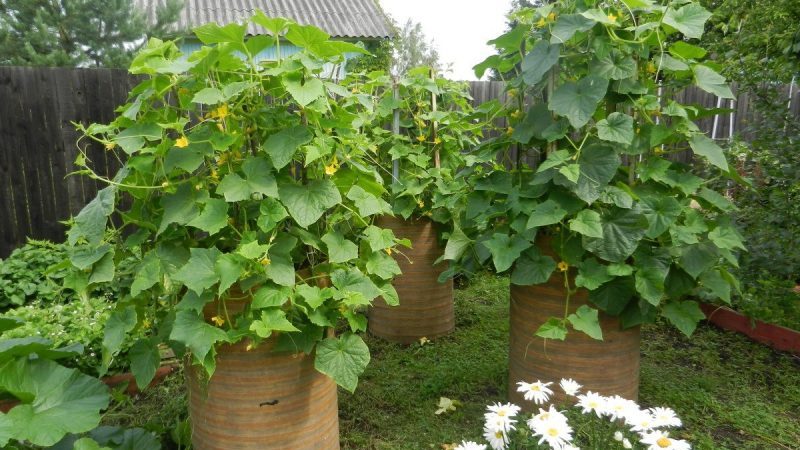
Growing cucumbers in a barrel is not laborious and interesting. But leaving will be even easier if you follow these guidelines:
- Implement the simplest drip irrigation system. A plastic bottle of 5 liters or slightly less voluminous is suitable for this. Make multiple holes in the walls of such watering cans with a hot knitting needle or thick needle.
- Bury the prepared bottle in the ground so that only the neck remains on the surface. Then pour water into it, which will gradually moisten the soil around, which will reduce the number of approaches for surface irrigation.
- Do not rush to quickly give up the film. Sudden frosts and cold nights will nullify all your efforts.
- Do not neglect feeding. So fruiting will begin earlier and will be more abundant.
- Remember to do periodic weeding. Weeds take up nutrients and spread the pests.
Reviews of summer residents
Many gardeners see the benefits of barrel planting and are willing to share their experience.
Irina, Vologda: «The plot is small, and you always want to grow a lot on it, and even allocate a place for flowers. Therefore, as I found this method, I decided that I would definitely implement it, and did not regret it! I put unnecessary plant debris and old tops immediately into barrels. There are three of them in the works and all fill up during the planting season. The grass around the site, broken dry raspberries, leaf litter - everything goes into action. I water the prepared soil abundantly with hot water, disinfect it, and the cucumbers hatch the next day. For the frame, a metal stick was fitted in the center of the barrel with a bicycle wheel on top. I pull the ropes to it, and the whips then stretch upward. An interesting cylindrical cucumber bush turns out. The harvest is always more than that of the neighbors in the greenhouse. There are almost no sores. After all, my high bed is ventilated from all sides, and it is easier to see the pest at this height. It is convenient to harvest, because the fruits hang from the barrel. "
Olga, Syktyvkar: “I place the barrels next to the entrance to the house, along the veranda. I have been planting cucumbers for the last 5 years. I use wooden barrels of 150 liters. They fit perfectly into our country style. The scourges cover an unremarkable wall of the house. I water the cucumbers along with the flowers at the facade as needed. Sometimes I go to the house, sometimes my husband and children; a little the leaves wilted - right behind the watering can. There is no need to run to the garden. It is very convenient. Guests always pay attention to such an original landing even more than to the alpine slides on the site and other interesting ideas. "
Conclusion
The method of growing cucumbers in a barrel is becoming more and more popular among gardeners. The method is good for its low labor intensity, interesting in appearance and huge savings in space. Do you like something original? Cucumbers in a barrel - your choice!